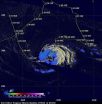(Press-News.org) NASA's TRMM satellite noticed that the intensity of rainfall in Tropical Storm Nadine has diminished today, Sept. 27.
The Tropical Rainfall Measuring Mission or TRMM satellite passed over Tropical Storm Nadine on Sept. 27 at 0739 UTC (4:39 a.m. EDT) and at 0917 UTC (5:17 a.m. EDT). At NASA's Goddard Space Flight Center in Greenbelt, Md., several TRMM instruments were used to create a full picture of Nadine's weakened rainfall. The image was created with an enhanced infrared image from TRMM's Visible and InfraRed Scanner (VIRS) overlaid with rainfall data derived from TRMM's Microwave Imager (TMI) instrument. The rainfall image showed Nadine had light rainfall almost surrounding the center of circulation. The heaviest intensity of about 20mm/hour (~.8 inches) appears to be located just northeast of the center.
NASA's Hurricane and Severe Storms Sentinel or HS3 mission sent out the unmanned Global Hawk aircraft to investigate Tropical Storm Nadine again on Sept. 26 and it returned to NASA's Wallops Flight Facility in Wallops Island, Va. on Sept. 27. While over Tropical Storm Nadine, the Global Hawk captured data using instruments aboard and also dropping sensors called sondes into the storm. The dropsonde system ejected the small sensors tied to parachutes that drift down through the storm measuring winds, temperature and humidity.
At 11 a.m. on Sept. 27. Tropical Storm Nadine had maximum sustained winds near 60 mph (95 kmh) and some strengthening is possible, according to the National Hurricane Center. It is located near latitude 28.7 north and longitude 32.4 west. Nadine is moving toward the west-southwest near 7 mph (11 kmh) and is expected to turn west then northwest as it moves around a high pressure area.
Tropical Storm Nadine has now been meandering around within the Atlantic Ocean for sixteen days.
INFORMATION:
NASA sees light rainfall in Tropical Storm Nadine
2012-09-28
ELSE PRESS RELEASES FROM THIS DATE:
Simulations uncover 'flashy' secrets of merging black holes
2012-09-28
VIDEO:
Supercomputer models of merging black holes reveal properties that are crucial to understanding future detections of gravitational waves. This movie follows two orbiting black holes and their accretion disk during...
Click here for more information.
According to Einstein, whenever massive objects interact, they produce gravitational waves -- distortions in the very fabric of space and time -- that ripple outward across the universe at the speed of light. While astronomers ...
Landsat satellites find the 'sweet spot' for crops
2012-09-28
Farmers are using maps created with free data from NASA and the U.S. Geological Survey's Landsat satellites that show locations that are good and not good for growing crops.
Farmer Gary Wagner walks into his field where the summer leaves on the sugar beet plants are a rich emerald hue -- not necessarily a good color when it comes to sugar beets, either for the environment or the farmer. That hue tells Wagner that he's leaving money in the field in unused nitrogen fertilizer, which if left in the soil can act as a pollutant when washed into waterways, and in unproduced ...
NASA sees a western weakness in Tropical Storm Miriam
2012-09-28
NASA infrared satellite imagery showed Tropical Storm Miriam had strong convection and thunderstorm activity in all quadrants of the storm on Sept. 26, except the western quadrant. That activity waned dramatically in 24 hours because of strong wind shear and cooler sea surface temperatures.
The Atmospheric Infrared Sounder (AIRS) instrument that flies aboard NASA's Aqua satellite captured infrared data on Tropical Storm Miriam on Sept. 26 at 2047 UTC, when it was off the coast of Baja California. Strongest thunderstorms with very cold cloud top temperatures appear to ...
NASA sees a wide-eyed Super Typhoon Jelawat
2012-09-28
One day ago, Super Typhoon Jelawat's eye was about 25 nautical miles in diameter, today, Sept. 27, NASA satellite data indicated that eye has grown to 36 nautical miles!
The latest infrared image from the Atmospheric Infrared Sounder (AIRS) instrument that flies on NASA's Aqua satellite shows a clear eye in Typhoon Jelawat on Sept. 25. The cloud top temperatures of the thunderstorms surrounding the eye exceed -63 Fahrenheit (-52 Celsius) indicating that they are very powerful and heavy rainmakers.. Jelawat also has a rounded shape indicating that circulation is strong ...
NASA sees Tropical Storm Ewiniar embedded in low pressure
2012-09-28
NASA's Aqua satellite passed over Tropical Storm Ewiniar and noticed strong convection still persists in the storm, despite now being embedded in a subtropical area of low pressure off the coast of Japan.
As Tropical Storm Ewiniar continues to move northward it wound up in an elongated area of low pressure (called a trough) off Japan's east coast. The trough is bringing a strong westerly flow of air into Ewiniar. Despite being battered by those winds, infrared data from the Atmospheric Infrared Sounder (AIRS) instrument that flies aboard NASA's Aqua satellite is showing ...
Study shows the MDHearingAid to be an effective low cost solution to hearing loss
2012-09-28
Washington, D.C. - A study presented at the American Academy of Otolaryngology - Head & Neck Surgery Foundation Annual Meeting in Washington, D.C. shows that the MD Hearing Aid line offers a reasonable low-cost solution to those who are not using hearing aids or other amplification devices because of cost concerns.
In the study, researchers at the Michigan Ear Institute sought to evaluate a novel, inexpensive (under $200.) over- the-counter hearing aid regarding to its acoustic properties and also to test the hearing aid on patients with varying levels of hearing loss ...
Major genetic discovery explains 10 percent of aortic valve disease
2012-09-28
This press release is available in French and German.MONTREAL, Canada, September 28, 2012 - Researchers at the Sainte-Justine University Hospital Center and University of Montreal have identified genetic origins in 10% of an important form of congenital heart diseases by studying the genetic variability within families. "This is more than the sum of the genes found to date in all previous studies, which explained only 1% of the disease, says Dr. Marc-Phillip Hitz, lead author of the study published in PLOS Genetics, under the direction of Dr. Gregor Andelfinger, pediatric ...
Making headway on beta-blockers and sleep
2012-09-28
Boston, MA—Over 20 million people in the United States take beta-blockers, a medication commonly prescribed for cardiovascular issues, anxiety, hypertension and more. Many of these same people also have trouble sleeping, a side effect possibly related to the fact that these medications suppress night-time melatonin production. Researchers at Brigham and Women's Hospital (BWH) have found that melatonin supplementation significantly improved sleep in hypertensive patients taking beta-blockers.
The study will be electronically published on September 28, 2012 and will be ...
Effective HIV care benefited all HIV patients, regardless of demographics and behavioral risk
2012-09-28
Improved treatment options, a multi-pronged treatment model, and federal funding from the Ryan White Program have helped an inner city Baltimore clinic improve outcomes for HIV patients across all groups, including those most often hardest hit by the disease. Published in Clinical Infectious Diseases, the results from the 15-year analysis of patients at a clinic serving a primarily poor, African-American patient population with high rates of injection drug use demonstrate what state-of-the-art HIV care can achieve, given appropriate support.
Current antiretroviral therapy ...
Eliminating invasive cervical cancer possible, Moffitt Cancer Center researchers report
2012-09-28
Researchers at Moffitt Cancer Center and colleagues at the University of South Florida and The Ohio State University have published a paper in the September issue of Cancer Epidemiology, Biomarkers & Prevention that provides an overview on preventing invasive cervical cancer.
"The good news is that over the past several decades, the incidence of invasive cervical cancer has declined dramatically," said senior author Anna R. Giuliano, Ph.D., director of Moffitt's Center for Infection Research in Cancer and senior member of the Cancer Epidemiology Department. "The bad ...




